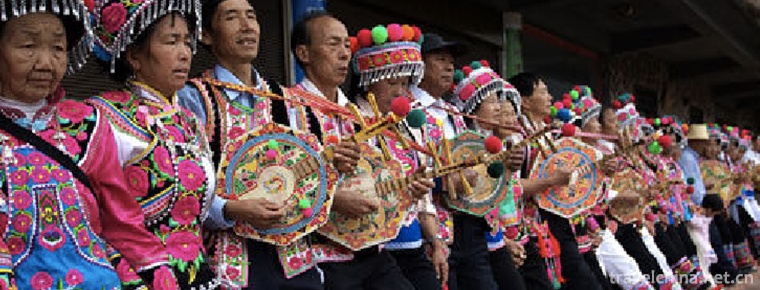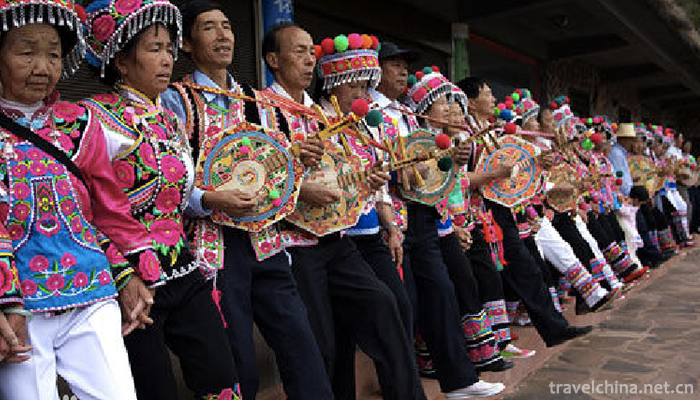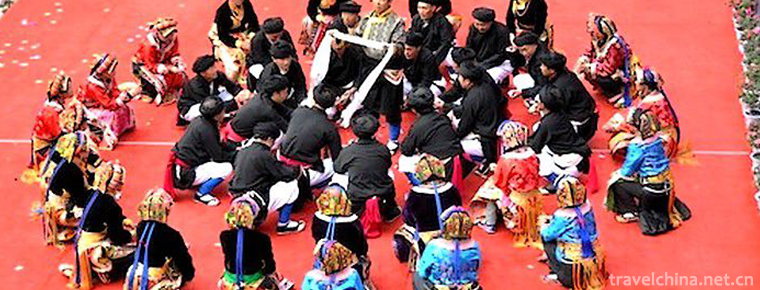2019-04-04

- By ChinaWiki.net
- Chinese Edition
- 2019-07-13
Left Foot Dance of Yi Nationality
The left foot dance of the Yi people, which is called "Gouzha" in the Yi language, falls to the left foot. Dao Guangnian's Dingyuan County Chronicle says, "It's called falling on the left foot. It starts with the left foot." Left-foot dance is a kind of representative traditional dance formed by the Yi people in their long-term social life, aiming at entertaining, communicating and keeping fit, taking songs and dancing as its content, and including the Yi people's worship of heaven, earth, sun, moon, fire, tiger, primitive, natural and many cultural manifestations. Left-foot dance originated in the primitive society of the indigenous Yi People 2000 years ago. After a long development of human society, a relatively fixed left foot singing and dancing method and singing method have been formed. For thousands of years, left-foot dancing culture of the Yi people, which takes the form of left-foot dancing, has been loved by the children of the Yis in Mouding.
On June 7, 2008, the left foot dance of the Yi nationality declared by Muding County, Yunnan Province, was listed in the second batch of national intangible cultural heritage list with the approval of the State Council. Heritage serial number: 670 III-73.
historical origin
Left foot dance is a traditional dance of the Yi people. Left-foot dance has a history of more than 1000 years. As early as 41 years of Kangxi (1702), there were the earliest written records of left-foot dance. Left-foot dance, which has been inherited for thousands of years, is the most popular and influential dance of the Yi people in Yunnan, and is known as the living fossil of the Yi culture.
Left foot dance, also known as "beating dance", "dancing song", "jumping foot", "overlapping foot" and "jumping left foot", is widely prevalent in most areas of Chuxiong Yi Autonomous Prefecture. The left-foot dance in Mouding area is mainly represented by the dancing methods of the two branches of the Yi nationality, Nipo and Lipo, commonly known as "left-foot jumping" and "foot jumping". However, when the Yi family is celebrating marriage, auspicious ceremonies and customs, traditional festivals and leisure time, people will spontaneously have a few dozen people, more than a hundred people, surrounded by bonfires or surrounded by thousands of people. Circles, left-foot dancing, boys roughly play the four strings of the tap, while girls sing the left-foot tune loudly, jumping heartily, all night long. The largest jumping event in China is the annual traditional March meeting, which has a history of more than 400 years. Qing Kangxi's Dingyuan County Chronicle says that on March 28, 40,000 businessmen, Jia Han Yi, sold clothes and goods at Dongyue Palace (Temple) in the southern suburbs of the city and scattered in three directions in early April. In the evening, more than 100 men and women, playing gourds, moon piano, mouth string, singing Yiqu, stamping around the left foot, to the rest of the square scattered.
Mouding left foot dance was selected into the second batch of national intangible cultural heritage list approved by the Ministry of Culture by the State Council in 2008.
For hundreds of years, on the 16th and 27th, 28th and 293rd days of the first lunar month or on the 27th, 28th and 29th days of the lunar calendar, people of Yi and other nationalities from far and near came unasked at sunset, playing the leading strings, singing left-footed tunes in harmony or in chorus, holding hands and shoulder to shoulder, forming a dozen-odd circles. Up to the circle of hundreds of people, dancing left foot. Accompanied by clanking strings and high and crisp tunes, they sometimes shuffle their feet, sometimes fold their feet, sometimes shake their legs against their feet, and sometimes turn around, with neat and unified steps and graceful dancing postures. "Yi Folk Song and Dance - Left Foot Dance" is composed of "Camellia Blossom on the Top of the Alpine Mountains", "Don't Wait for Little Sister White", "Pine and Green Yin on the Yi Mountains", "Cabbage and Cabbage Moss", "Our Reunion Tonight", "A Good Place in the Xinhua Mountains", "A Ge A Mei Jumping Feet", "Catching Meet" and "Little Brother and Little Sister Playing", "《 The song "The Year of Good Harvest" is composed of ten tracks. Mou Ding, the hometown of left foot dance. The 27-29 March of the lunar calendar is the "March Meeting" of the national traditional festival. At that time, it is not only the sea of Yi people's singing and dancing, but also the heat wave of commercial activities.
artistic characteristics
Left foot adjusting is lively, easy to understand, simple and natural, expressive, singing for high octave tune, crisp and melodious, high-spirited and enthusiastic, with strong local cultural characteristics. There are more than 300 left-foot tunes widely circulated in Mouding County. Among them, the representative of Yis'toast song "Like it or not, Drink it" is the representative of left-foot tune.
Current situation of inheritance
Left-foot dance is an important symbol of the traditional excellent culture of the Yi people. It contains all the deep-seated cultural accumulation of the social development history and lifestyle of the Yi people. It is the most popular and influential species of the Yi people in Yizhou and is known as the living fossil of the Yi culture. Left-foot Dance Culture Festival is a large-scale local festival which integrates cultural activities, tourism activities, academic activities and economic and trade activities. It originated from the annual traditional festival "March Meeting".
Every year during the three days from March 27 to 29 of the lunar calendar, thousands of people of Yi, Han and Miao nationalities, both at home and abroad, dress up in gorgeous Festival dresses and come together to the county town to celebrate the festival. They join hands, shoulder to shoulder, surrounded by dozens of large circles, accompanied by the clanking sound of four strings and the crisp and pleasant music. Left foot tone dance together happy left foot dance, sometimes flashing back and falling feet, sometimes dismantling steps and closing feet, dance steps neat and unified, the atmosphere is very warm. At night, bonfires are lit and dancing around the fire. The whole Mouding County became a sea of singing and dancing, and the scene was very spectacular. For most young Yi men and women, the purpose of the March meeting is to dance left-foot dance and talk about love.

Ask a Question
Your email address will not be published.


0 Questions